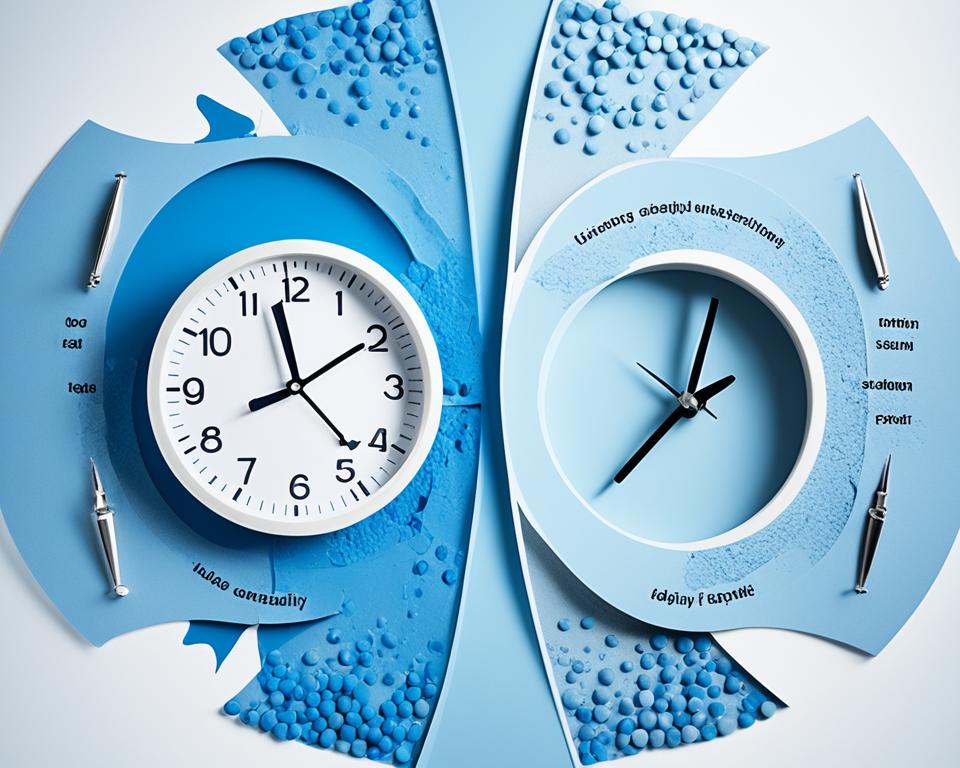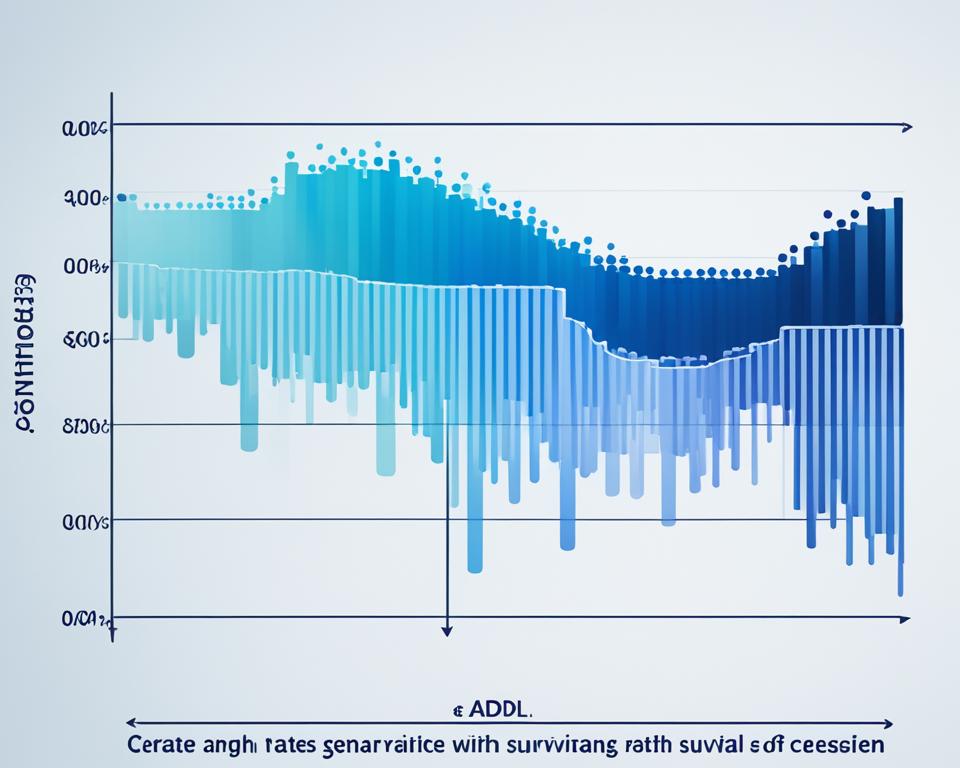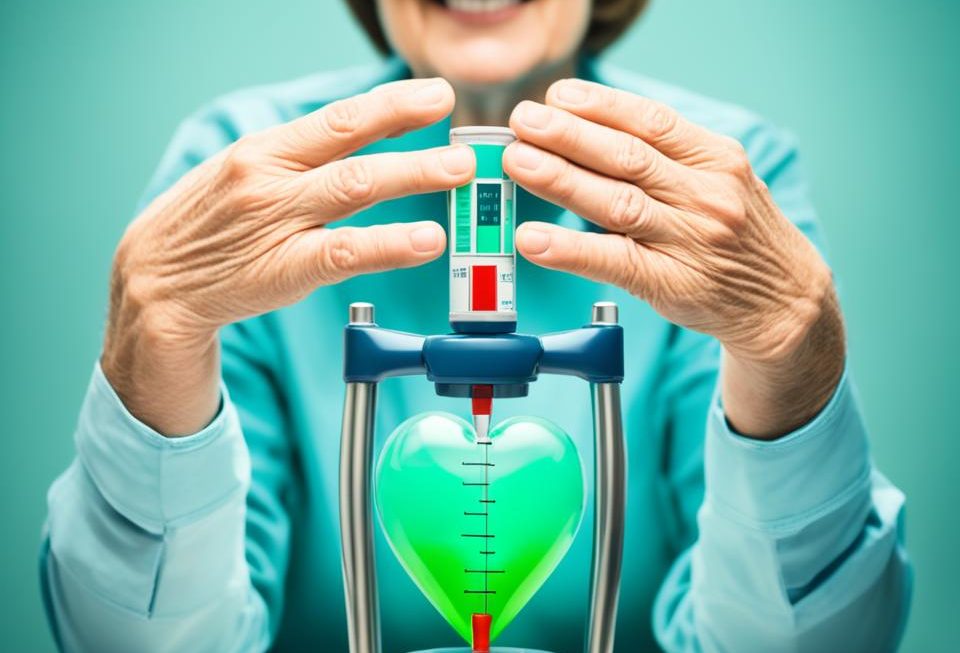Exploring dialysis and kidney failure can seem overwhelming. Yet, it’s key to know about patient life expectancy. This info is vital for making good choices and ensuring care is well-informed. We dive into the latest findings on how long dialysis patients live, revealing the elements that affect survival.
Comparing hemodialysis with peritoneal dialysis and looking at age and kidney health’s role, we offer a full look at a dialysis patient’s path. By grasping the ins and outs of dialysis survival figures, both healthcare pros and patients can craft plans for better outcomes. This can lead to an improved life for those facing kidney failure.
Read interesting things at : vetocellacvgummies
Key Takeaways
- Dialysis patient survival rates are influenced by various factors, including age, overall health, and underlying kidney disease.
- The average life expectancy for dialysis patients can vary significantly, with younger individuals generally experiencing longer survival times.
- Adherence to treatment regimens, dietary and lifestyle changes, and early intervention can all contribute to improved dialysis patient outcomes.
- Kidney transplantation remains the best option for long-term survival and quality of life for those with end-stage renal disease.
- Dialysis patients and their caregivers should have access to comprehensive support resources to help them navigate the challenges of living with kidney failure.
Introduction to Dialysis and Kidney Failure
Dialysis is a key treatment for those with kidney failure, also called end-stage renal disease (ESRD). When kidneys can’t work well, life-saving dialysis or a transplant becomes necessary.
What is Dialysis?
Dialysis cleanses the blood, doing what our kidneys should. It uses a special machine to take out waste and extra fluids. There are two types: hemodialysis and peritoneal dialysis.
Causes of Kidney Failure
Not looking after diabetes and high blood pressure can hurt your kidneys. This can lead to kidney failure. Other causes include glomerulonephritis and polycystic kidney disease, which damage the kidneys in different ways.
Knowing what causes kidney failure helps doctors choose the best treatments. This can improve kidney dialysis longevity and health.
“Dialysis is a lifeline for those with kidney failure, providing a way to filter waste and excess fluid from the body when the kidneys can no longer perform this essential task.”
Factors Affecting Dialysis Patient Survival
Dialysis is crucial for those with kidney failure. But, not all patients face the same odds. A few key elements decide how well individuals might do over time.
Age and Overall Health
The age and health of a dialysis patient really matter. Younger patients often stand a better chance than the elderly. They might not have as many other health problems.
But, older patients with more health issues might find it harder. They could have a lower chance of surviving longer on dialysis. They often need more care to help them pull through.
Underlying Kidney Disease
What caused a patient’s kidney failure plays a role too. Some causes lead to worse outcomes. Understanding the specific kidney disease helps in planning the best treatment.
If the kidney disease is fast-acting, starting dialysis earlier is key. It helps avoid serious complications and can make a big difference in survival.
| Key Factors Affecting Dialysis Patient Survival | Impact on Survival Rates |
|---|---|
| Younger Age | Higher Survival Rates |
| Older Age with Comorbidities | Lower Survival Rates |
| Underlying Kidney Disease (e.g., Diabetic Nephropathy) | Poorer Prognosis |
| Underlying Kidney Disease (e.g., Polycystic Kidney Disease) | Better Prognosis |
Knowing all these important factors helps doctors customize treatments. This can make a big difference in life expectancy and the quality of life of dialysis patients.
Hemodialysis vs. Peritoneal Dialysis
Patients with end-stage renal disease (ESRD) can choose between hemodialysis and peritoneal dialysis. This choice can greatly affect their hemodialysis life expectancy and peritoneal dialysis lifespan.
Hemodialysis filters the blood through a machine to clean it from waste and extra fluid. It happens in a dialysis center about three times a week, lasting for hours each time. This treatment can be hard due to the time it takes and the big changes in lifestyle.
Peritoneal dialysis, on the other hand, uses the patient’s peritoneal membrane to clean the blood. It’s done at home, several times during the day. This method gives patients more freedom and lets them keep a regular schedule. Yet, it needs patients to be very involved and might lead to more infections.
| Hemodialysis | Peritoneal Dialysis |
|---|---|
| Performed in a dialysis center, typically 3 times per week | Performed at home, several times per day |
| Requires vascular access (fistula or graft) | Requires the insertion of a peritoneal catheter |
| Can be more intensive, with longer treatment sessions | Offers more flexibility and independence for patients |
| Potential for greater disruption to daily routine | Requires more active patient involvement |
Choosing between hemodialysis and peritoneal dialysis needs the patient and their healthcare team to work together. They consider the patient’s health, lifestyle, and personal choices. Each method has good and not-so-good points. The right choice helps the patient’s hemodialysis life expectancy or peritoneal dialysis lifespan.
How Long Dialysis Patients Survive
Dialysis helps people with severe kidney problems live longer. But, how long will they live? It’s not an easy question to answer. The life expectancy on dialysis differs a lot. It changes by the person’s age, health, and why their kidneys failed.
Average Life Expectancy on Dialysis
Today, research tells us dialysis patients might live 5 to 10 years. Some could live longer or shorter depending on different things. For example, healthy younger folks often do better than older people with more health problems.
Survival Rates by Age Group
Age really matters in how well dialysis works. Research shows that if you’re 20 to 44 years old, you have a 92% chance to make it to the first year on dialysis. But, if you’re 65 to 74, this goes down to 72%. Looking at five years, younger patients have a 53% chance to make it. Yet, for the older group, it’s only 31%.
Age and health really shine when we talk about how long dialysis helps. Knowing these facts lets doctors and patients choose the best plan. It helps them face what might come in the future.
Improving Dialysis Patient Outcomes
People with end-stage renal disease (ESRD) who need dialysis must focus on improving their health. They can extend their life and reduce the risk of death on dialysis. How? By carefully controlling what they eat, how they live, and following doctor’s orders closely. This is essential for better health and a longer life.
Dietary and Lifestyle Changes
Eating right is a key step for those on dialysis. They should watch their sodium, potassium, and phosphorus intake. Eating enough protein is crucial to keep muscles strong. Adding in foods full of nutrients helps the body work better. And getting enough to drink each day is important too.
- Limiting intake of sodium, potassium, and phosphorus to manage fluid balance and mineral levels
- Consuming adequate protein to maintain muscle mass and strength
- Incorporating nutrient-dense foods rich in vitamins and minerals to support the body’s functions
- Staying hydrated by drinking the recommended amount of fluids
Moving your body is also vital. Exercises help your heart, muscles, and keep you feeling your best. Even light exercises, strength, and aerobic workouts are great. They help with muscle strength, heart health, and your overall mood.
Adhering to Treatment Regimen
Sticking to your dialysis plan is very important. This means not missing any treatment. You also need to follow your treatment’s schedule closely. Taking all medications your doctor gives you is a must. And telling your healthcare team about any health changes is critical.
- Attending all scheduled dialysis sessions without missing or skipping appointments
- Closely following the recommended dialysis duration and frequency
- Taking all prescribed medications as directed, including any supplements or therapies
- Regularly monitoring and reporting any changes in health or symptoms to the healthcare team
By being strict with your treatment and lifestyle changes, you can live longer. You also lower the risk of death from dialysis. It’s all about regularly doing what you need to do and staying informed.
Dialysis Mortality Risks and Complications
People on dialysis face various health risks and complications. These can greatly affect how long they live and their life quality. It’s important for both patients and their doctors to be aware of these risks.
A big worry for those on dialysis is heart problems. The stress on the heart from dialysis can cause or make worse heart failure, arrhythmias, and atherosclerosis. These heart issues are a top reason why people on dialysis die.
If dialysis access sites get infected, it’s a serious problem. Vascular catheters or peritoneal dialysis ports can cause infections. If these infections aren’t treated fast, they can lead to sepsis and other very dangerous problems.
- Cardiovascular disease, including heart failure and arrhythmias
- Infections, particularly those related to dialysis access sites
- Fluid and electrolyte imbalances
- Anemia and related complications
- Bone and mineral disorders
Other risks for dialysis patients include problems with fluids, anemia, and bone health. If not managed well, these can increase the risk of death. It’s vital to closely follow the dialysis treatment plan to avoid these issues. Sticking to the treatment and going for regular check-ups is key.
Healthcare providers work on many fronts to lower these risks. They keep a close eye on heart health, work hard to prevent infections, and help with the right diet and medicines. By tackling these issues early, patients on dialysis can have a better chance at a longer life and improved living conditions.

“The ultimate goal is to empower dialysis patients with the knowledge and resources to actively participate in their own care, thereby reducing the burden of complications and enhancing their overall survival.”
Kidney Transplantation and Survival Rates
Kidney transplantation offers a big jump in survival and future health for those with end-stage renal disease. It’s mainly the top choice for people with kidney failure. It replaces the old kidney, ending the need for dialysis.
United Network for Organ Sharing (UNOS) says kidney transplant survival rates are very encouraging. After one year, about 95% of the recipients are still alive. After five years, this drops slightly to 85%. These numbers are much higher than for those on dialysis.
Many things play into a transplant’s success, like the age and health of the person getting the kidney. The kind of transplant and how well the donors and receivers match also matter. Plus, it’s crucial that the recipient takes their medicines as they should.
Getting a new kidney can change a person’s life if they have end-stage renal disease. It not only increases how long they live but also how well they can live. This option gives hope to those struggling with kidney failure.
| Survival Rates for Kidney Transplant Recipients | Survival Rates for Dialysis Patients |
|---|---|
| 1-year survival rate: ~95% | 1-year survival rate: ~85% |
| 5-year survival rate: ~85% | 5-year survival rate: ~50% |
Because of the high survival rates, kidney transplants are a great choice for those with kidney failure. Knowing all this helps patients and their doctors pick the best treatment for end-stage renal disease.
“Kidney transplantation can be a life-changing event for those with end-stage renal disease, offering improved survival rates and enhanced quality of life.”
Calculating Life Expectancy with Kidney Failure
Finding out how long people with kidney failure can live is crucial. It helps in planning their care. Doctors and experts use many tools to show how long someone might live. This info is important for patients and their families to make choices.
The Charlson Comorbidity Index is a key way to figure out life expectancy with kidney failure. It looks at how different health issues like heart problems, diabetes, and cancer affect survival. This helps doctors guess how much longer the patient might live and set up a treatment plan.
The Karnofsky Performance Scale is also very common. It checks how well a patient can do daily tasks. Knowing this can shed light on their future and lets health teams work better to help the patient.
Many things are looked at when trying to guess how long someone with kidney failure might live. These include:
- Age at diagnosis
- How bad the kidney disease is
- How they respond to dialysis
- Other health issues they have
- How well they follow diet and lifestyle changes
By weighing these pieces of information, doctors get a good picture of the situation. They can then offer tailored advice on how to deal with kidney failure and improve the chances of living longer.
“Accurate prognosis is essential for patients and their families to make informed decisions about their care and to plan for the future.”
Figuring out life expectancy with kidney failure is not easy. It involves looking at many details about the patient. Doctors use proven methods and tools to help patients and their families understand and face this challenge.
End-Stage Renal Disease Survival Statistics
It’s vital to know the survival rates for ESRD patients. This helps in dealing with ESRD. Latest data from healthcare sources gives us a look at what to expect over time.
In the U.S., about 40% of dialysis patients make it past 5 years. This tells us that 4 out of 10 people with ESRD might live for 5 years or more. But, this number can change based on many factors.
Dialysis Modality and Survival Rates
The type of dialysis, like hemodialysis or peritoneal dialysis, really matters. Research shows more people survive up to 5 years with peritoneal dialysis than with hemodialysis.
| Dialysis Modality | 5-Year Survival Rate |
|---|---|
| Hemodialysis | 38% |
| Peritoneal Dialysis | 42% |
Comorbidities and Survival Rates
Other health problems like diabetes or heart issues can reduce ESRD patient survival chances. More health issues mean it’s harder to live longer with ESRD.
“Comprehensive management of comorbidities is essential for improving the long-term survival of ESRD patients on dialysis.”
Knowing the latest survival data and what affects outcomes is key. It helps doctors and patients plan better. This is true for dialysis and long-term care.

Coping with Dialysis and Quality of Life
Going through dialysis is tough and changes your life. But with the right help, people on dialysis can enjoy life and handle the treatment. It’s key to know how dialysis affects your body, mind, and feelings to deal with it well.
For patients on dialysis, their body takes a big hit. The treatment makes them tired, causes muscle pain, and brings other aches. Adding light exercises, like easy workouts, can make you stronger. Eating well and drinking enough water also help beat dialysis challenges.
The treatment might also make you feel sad, worried, or like you’ve lost control. Joining a support group or seeing a mental health expert can really help you handle these ups and downs. Trying out meditation, yoga, or your favorite hobbies can make you feel better too.
Still, many people manage to have a great life while on dialysis. Having the right attitude, support, and knowing your options can make you not just cope, but thrive. Even with this serious treatment, it’s possible to enjoy every day.
The real secret to living well with dialysis is to tackle everything – physical, emotional, and mental challenges. By facing these struggles properly, dialysis patients can boost their dialysis patient survival statistics and life expectations. This way, they can lead rich, satisfying lives despite the health hurdles.
Dialysis Patient Support Resources
Living with kidney disease and being on dialysis is tough. It can feel like an uphill battle. But, there’s help out there. Many support groups and resources want to help patients and their families. They aim to make life easier, boost its quality, and make sure patients can keep going with kidney dialysis longevity.
Patient advocacy organizations are key for dialysis patients. Groups like the National Kidney Foundation and the American Association of Kidney Patients do a lot. They offer info, support groups, and help with dialysis survival stats and end-stage renal disease outcomes. They also fight for patients’ rights and try to make healthcare better.
Healthcare professionals are also there for dialysis patients. Nephrologists, nurses, and social workers can give advice and support. They help patients pick the right treatments, manage symptoms, and create good care plans for their health and happiness.
Dialysis centers provide help, too. They have workshops, support groups, and counseling services. These can really help patients and their loved ones deal with the day-to-day and emotional challenges of kidney disease.
There are also lots of online resources for extra support. Forums, websites, and apps offer tips and connect patients with others. This community can share experiences and advice, making everyone feel less alone in their journey.
Don’t forget about the dialysis patient support resources out there. They empower patients with kidney disease to live longer lives. While the condition is a challenge, it doesn’t have to stop anyone from a happy life.
“With the right support and resources, dialysis patients can not only survive, but thrive.”
Conclusion
Dialysis patients’ survival is affected by many things. These include age, the type of kidney disease, and how well they stick to their treatment. The chance of living longer with dialysis changes a lot from person to person.
It’s important for patients and doctors to know about dialysis life expectancy, kidney failure survival rates, and renal disease prognosis. This helps make smart choices and find ways to increase dialysis patient survival and quality of life. Looking into help and support is key for improving dialysis patient outcomes and dealing with the issues that come with kidney failure and its treatment.
Our understanding of kidney treatment keeps getting better with medical research and technology. This means the outcomes for people on dialysis might improve. By learning and being active about their health, those with kidney issues can face the future with strength. This can lead to dialysis patient survival statistics that bring hope and positive results.



